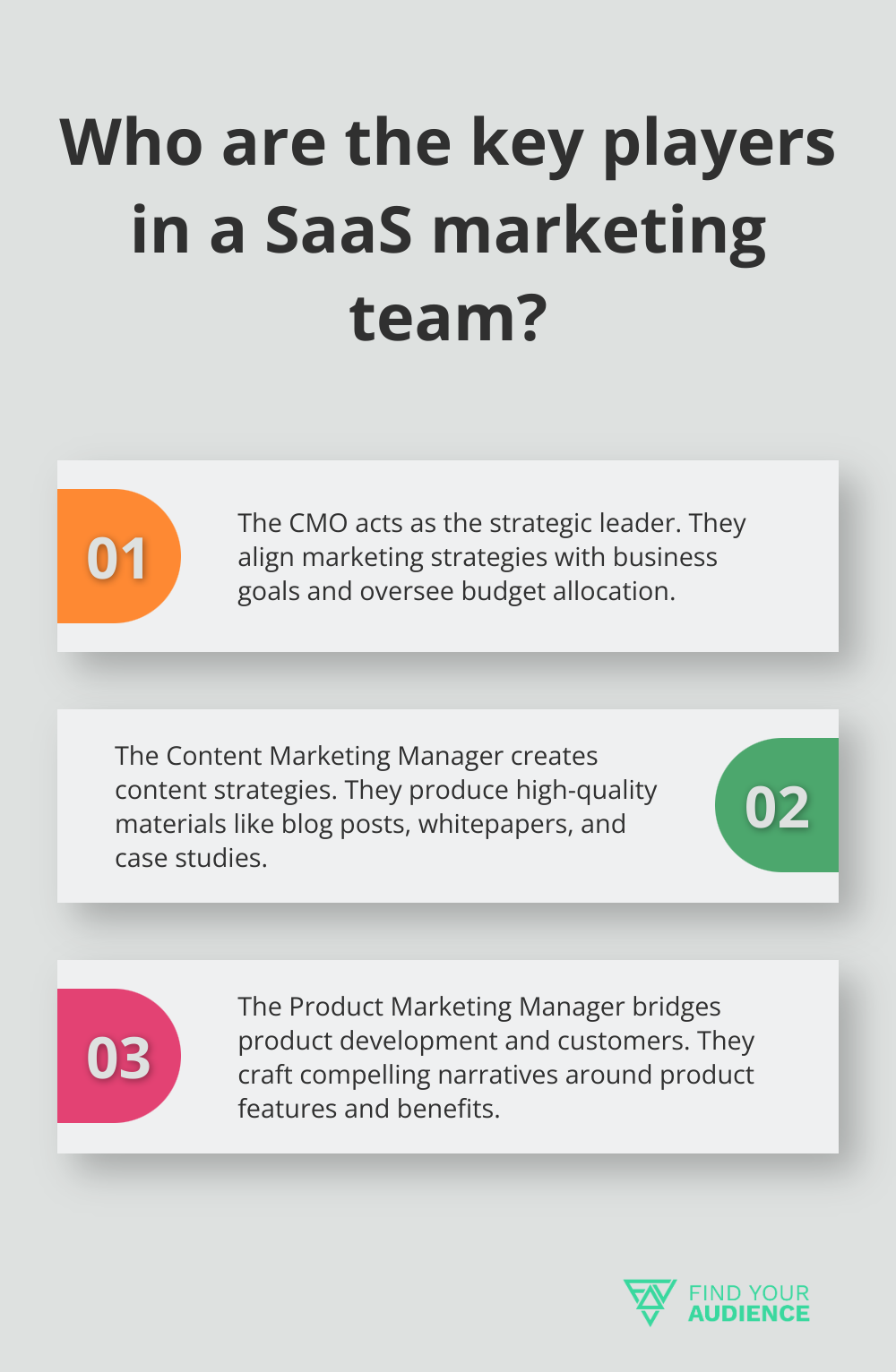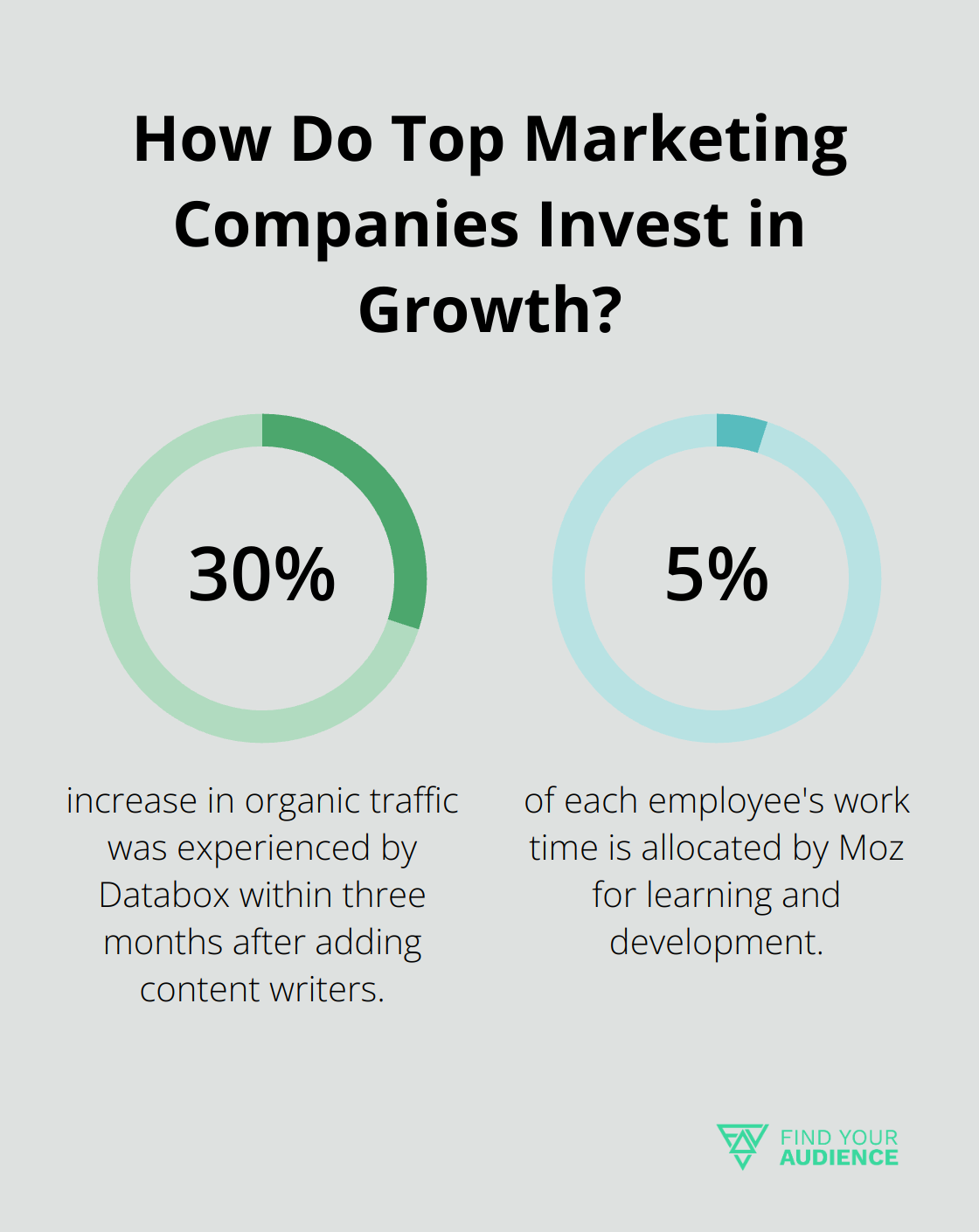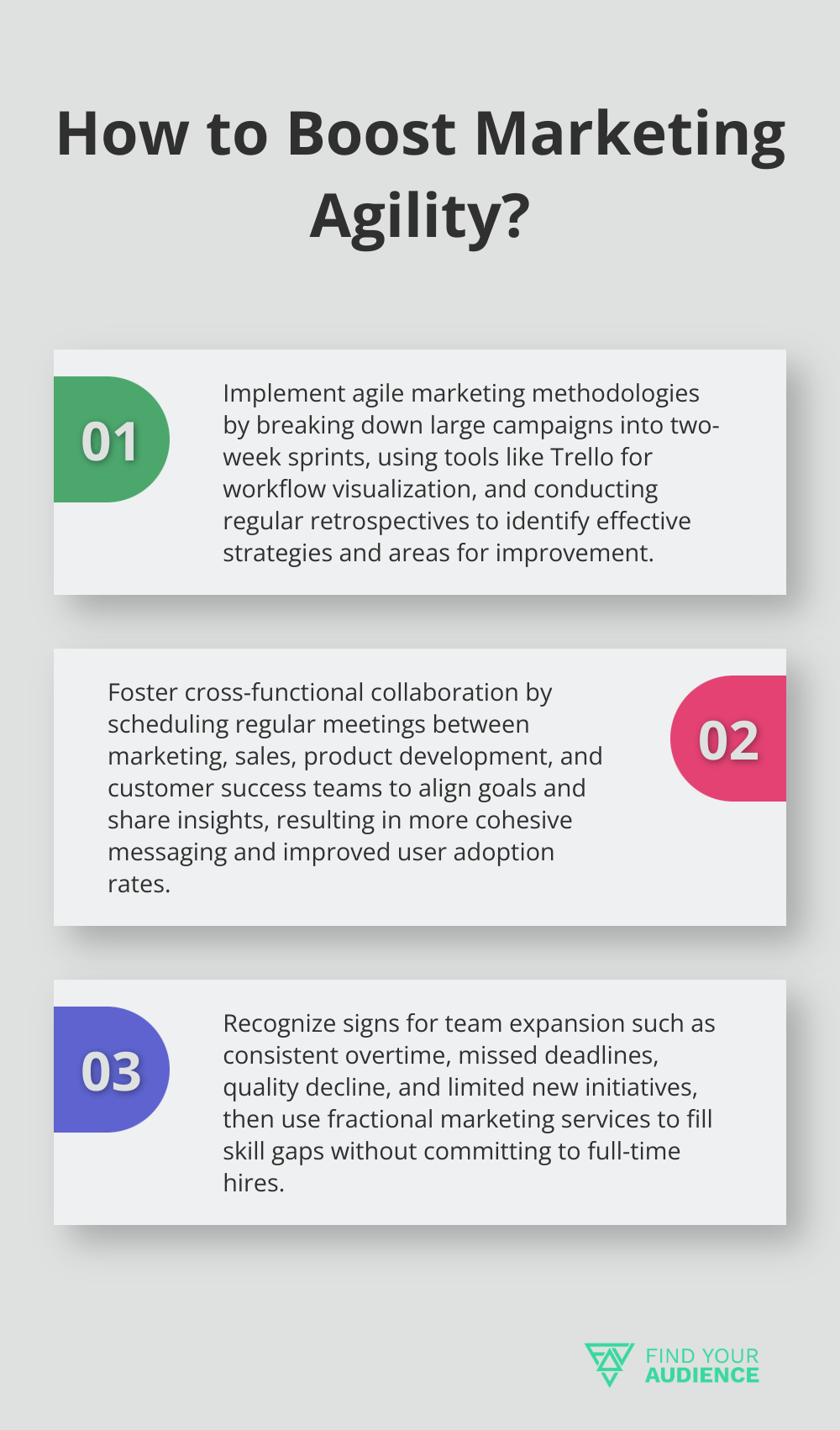How to Structure Your SaaS Marketing Team
Building an effective SaaS marketing team structure is crucial for driving growth and success in the competitive software industry. At Find Your Audience, we’ve seen firsthand how the right team composition can make or break a SaaS company’s marketing efforts.
This guide will walk you through the key roles, strategies for structuring your team, and tips for scaling as your business grows. We’ll also explore how to balance in-house talent with external resources to create a dynamic and adaptable marketing powerhouse.
Key Players in a SaaS Marketing Team
A well-structured SaaS marketing team forms the foundation of successful growth strategies. Let’s explore the essential roles that constitute an effective marketing team.
The Strategic Leader: Chief Marketing Officer (CMO)
The CMO acts as the visionary behind your marketing efforts. They align marketing strategies with overall business goals, oversee budget allocation, and ensure cohesion across all marketing initiatives. A great CMO in the SaaS space must be data-driven, tech-savvy, and able to adapt quickly to market changes.

HubSpot’s CMO, Kipp Bodnar, exemplifies this role. He has spearheaded the company’s inbound marketing strategy, which has become a benchmark in the industry. His focus on how HubSpot thinks about social media and how their go-to-market strategy has changed as the company has grown has helped HubSpot maintain its position as a leader in the CRM space.
The Content Mastermind: Content Marketing Manager
In SaaS, content reigns supreme. The Content Marketing Manager creates and oversees the execution of content strategies that educate, engage, and convert prospects. They produce high-quality blog posts, whitepapers, case studies, and other materials that showcase your product’s value.
Intercom’s content team has set a high bar in the industry. Their Inside Intercom blog and books have become go-to resources for SaaS professionals, demonstrating the power of thought leadership in driving brand awareness and customer acquisition.
The Product Storyteller: Product Marketing Manager
The Product Marketing Manager bridges the gap between your product development team and your customers. They craft compelling narratives around your product features, benefits, and updates. This role proves vital in SaaS, where communicating complex features in an easily digestible manner can significantly impact user adoption.
Slack’s product marketing team excels at this, consistently rolling out new features with clear, engaging messaging that highlights user benefits. Their approach to product storytelling has contributed significantly to Slack’s rapid growth and high user engagement.
The Growth Engine: Demand Generation Specialist
The Demand Generation Specialist focuses on creating and nurturing leads through various channels. They work closely with sales teams to develop campaigns that attract qualified leads and move them through the sales funnel.
Salesforce’s demand generation team is known for its multi-channel approach, combining webinars, email marketing, and targeted advertising to drive consistent growth. Their success underscores the importance of a robust demand generation strategy in SaaS marketing.
The Data Wizard: SEO and Analytics Expert
In the digital-first world of SaaS, an SEO and Analytics Expert proves indispensable. They optimize your online presence to attract organic traffic and provide data-driven insights to refine marketing strategies.
Moz, a leader in SEO software, naturally excels in this area. Their SEO team’s efforts have not only boosted their own visibility but have also set industry standards for SEO best practices.
While these roles form the core of a SaaS marketing team, the specific needs of your company may vary. Some organizations might benefit from additional specialists like a Marketing Automation Expert or a Customer Success Marketer.
For companies looking to build or enhance their SaaS marketing team without the overhead of full-time hires, a fractional marketing solution (like the one offered by Find Your Audience) can provide access to top-tier talent without the recruitment hassle.
Now that we’ve identified the key players, let’s explore how to structure these roles for maximum effectiveness and success.
How to Structure Your SaaS Marketing Team for Success
Align Roles with Business Objectives
Your SaaS marketing team structure should mirror your company’s goals. Define your primary objectives: rapid user acquisition, increased customer retention, or expansion into new markets. Then, shape your team accordingly.

For user acquisition focus, prioritize roles like Demand Generation Specialist and SEO Expert. When targeting enterprise clients, strengthen your content marketing team to produce comprehensive whitepapers and case studies.
Salesforce demonstrates this approach effectively. As they expanded into various cloud solutions, they restructured their marketing team to include specialists for each product line. This strategy ensures focused messaging and targeted campaigns.
Create Clear Communication Channels
In the fast-paced SaaS environment, information silos can hinder progress. Implement tools and processes that promote seamless communication across your marketing team and other departments.
Try project management tools like Asana or Monday.com to track campaign progress and assign tasks. Use Slack for quick, informal communication, and schedule regular stand-ups to maintain alignment.
Atlassian’s marketing team uses their own product, Confluence, as a central knowledge base for marketing strategies, brand guidelines, and campaign results. This approach ensures universal access to the latest information and minimizes communication redundancy.
Implement Agile Marketing Methodologies
The SaaS industry evolves rapidly, and your marketing team must keep pace. Implementing agile methodologies helps your team respond swiftly to market changes and customer feedback.
Break down large campaigns into smaller, manageable sprints. Use tools like Trello to create kanban boards for workflow visualization. Conduct regular retrospectives to identify effective strategies and areas for improvement.
HubSpot’s marketing team has successfully implemented agile marketing. They operate in two-week sprints, allowing quick idea testing and strategy pivots based on results. This approach has helped them maintain a competitive edge in the CRM space.
Foster Cross-functional Collaboration
Effective SaaS marketing requires close collaboration between marketing, sales, product development, and customer success teams. Encourage regular cross-departmental meetings and joint projects to align goals and share insights.
Slack (a popular communication tool) exemplifies this approach internally. Their marketing team works closely with product developers to ensure new features are communicated effectively to users. This collaboration results in cohesive messaging and improved user adoption rates.
Invest in Continuous Learning
The SaaS landscape changes rapidly, with new technologies and strategies emerging constantly. Prioritize ongoing education and skill development for your marketing team.
Allocate budget for courses, conferences, and workshops. Encourage knowledge sharing within the team through regular “lunch and learn” sessions or an internal wiki.
Moz (an SEO software company) invests heavily in employee education. They provide a learning stipend and dedicated time for professional development, ensuring their marketing team stays at the forefront of industry trends.
As your SaaS company grows, your marketing team structure will need to evolve. The next section will explore strategies for scaling your marketing team effectively, including when to hire new members and how to balance in-house talent with external resources.
When to Scale Your SaaS Marketing Team
Recognize the Signs for Expansion
Your SaaS company’s growth will necessitate changes in your marketing team. Identifying the right moment to scale is essential for sustained success. Several indicators suggest it’s time to expand your marketing efforts:
- Consistent overtime: Your team regularly works extra hours to meet demands.
- Missed deadlines: Projects frequently fall behind schedule.
- Quality decline: The standard of your marketing output drops.
- Limited new initiatives: Lack of bandwidth prevents pursuing fresh marketing strategies.

Databox (a business analytics platform) scaled their marketing team after noticing a plateau in content output. They added content writers and experienced a 30% increase in organic traffic within three months.
Use Fractional Marketing Services
Fractional marketing services offer a flexible solution for scaling. These services provide access to experienced marketers on a part-time or project basis, allowing you to fill skill gaps without committing to full-time hires.
A SaaS startup might bring in a fractional CMO to develop a comprehensive marketing strategy, then gradually build out their in-house team based on this roadmap. (Find Your Audience offers fractional marketing services tailored specifically for SaaS companies, providing expertise across various marketing functions.)
Strike a Balance Between In-house and External Resources
As you scale, finding the right mix of in-house talent and external agencies becomes important. In-house teams offer deep product knowledge and brand alignment, while agencies bring specialized expertise and fresh perspectives.
Zapier (a workflow automation tool) maintains a core in-house marketing team for strategy and product marketing, while partnering with agencies for specific campaigns and creative work. This approach allows them to maintain brand consistency while tapping into specialized skills as needed.
Prioritize Continuous Learning
As your team grows, investing in training and skill development becomes increasingly important. This improves your marketing efforts and aids in retention of top talent.
Moz (an SEO software company) allocates 5% of each employee’s work time for learning and development. This investment has led to innovative marketing strategies and improved employee satisfaction.
Implement a Phased Approach
Try a gradual approach to scaling your marketing team. Start by identifying the most pressing needs and addressing them first. This might involve hiring for specific roles or bringing in specialized agencies for particular projects.
As your needs evolve, continue to assess and adjust your team structure. (This flexible approach allows you to respond to changing market conditions and business goals more effectively.)
Final Thoughts
A successful SaaS marketing team structure aligns with business objectives and adapts to industry changes. Key roles like CMO, Content Marketing Manager, and SEO Expert form the foundation, but their integration and flexibility determine true effectiveness. Companies must foster clear communication, embrace agile methodologies, and promote cross-functional collaboration to stay competitive.

As SaaS businesses grow, scaling marketing efforts becomes essential. This may involve expanding in-house teams, using fractional marketing services, or balancing internal talent with external agencies. Regular assessment and adjustment of team composition ensure readiness for new challenges and opportunities in the dynamic SaaS landscape.
Find Your Audience offers fractional marketing services tailored for SaaS companies, providing access to experienced professionals across various marketing functions. This approach allows efficient scaling of marketing efforts, filling skill gaps and driving growth without traditional recruitment complexities. The key to success lies in creating a flexible, data-driven structure that aligns with company goals and evolves alongside the business.

